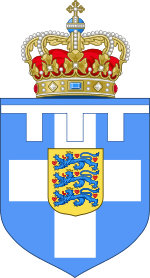Crown Prince of Greece

The Crown Prince of Greece (Greek: Διάδοχος, Diadochos) is the heir to the throne of modern Greece. Since the abolition of the Greek monarchy by the then-ruling military regime on 1 June 1973, it is merely considered a courtesy title.
Title
Neither the constitution of 1844 or 1864, which served as the basis for other fundamental laws of the Kingdom of Greece, recognised titles of nobility. On the contrary, they prohibited even the sovereign from conferring such titles.[1][N 1][N 2]
As a result, the heir apparent was usually referred to simply as "the diadochos" by virtue of his function, rather than as a title. The word diadochos (διάδοχος) simply means "successor, he who collects the estate". This is a deverbal of διαδέχομαι (diadéchomai), "receive by succession",[2] and has been used since the Archaic period for heirs-apparent.[3] The most famous bearers of the title were the Diadochi, the "Successors" of Alexander the Great, who contended with each other for the spoils of his empire.[4]
Only one crown prince, the future Constantine I, bore a separate title of nobility, that of "Duke of Sparta".
Succession
The London Conference of 1832, established a semi-salic line of succession which would pass the crown to Otto I's descendants, or his younger brothers (Luitpold Karl and Adalbert Wilhelm), should he have no issue. It was also decided that in no case would the crowns of Greece and Bavaria be joined in a personal union.[5]
From 1844, the constitution also established that the crown prince must profess the Orthodox faith,[1] which was not without difficulty as the royal dynasty at the time was Catholic. Since the establishment of the constitution of 1952, the daughters of the sovereign came after their brothers in the order of succession to the throne.
When Constantine II succeeded Paul I in 1964, his sister became heir presumptive according to the 1952 Constitution but that caused a constitutional crisis because his father's cousin Prince Peter who declared himself heir to the throne on the pretext that female dynasts had been unlawfully granted succession rights, but Prince Peter lost his succession rights by marrying Irina Aleksandrovna Ovtchinnikova in 1939. Also at the time Constantine's older sister Princess Sophia married Juan Carlos, Prince of Asturias in 1962 and cousin Prince Philip married Queen Elizabeth II in 1947 renounced their rights for their descendants.
In 1965 Prince Michael could have considered himself as crown prince renounced his rights when he married Marina Karella in 1965, the marriage is considered morganatic.
Insignia
-
.svg.png)
Standard of the Crown Prince
(1916–1924) -
.svg.png)
Standard of the Crown Prince
(1935–now)
House of Wittelsbach
| Name | Heir of | Birth | Became Heir | Created Crown Prince |
Ceased to be Crown Prince |
Death | Other titles | Crown Princess |
|---|---|---|---|---|---|---|---|---|
| Luitpold | Otto I | 12 March 1821 | 27 May 1832 | 23 October 1862 (disqualified from succession on 18 March 1844 as non-Orthodox) | 12 December 1912 | Prince of Bavaria | Archduchess Auguste Ferdinande of Austria | |
House of Glücksburg
| Name | Heir of | Birth | Became Heir | Created Crown Prince |
Ceased to be Crown Prince |
Death | Other titles | Crown Princess |
|---|---|---|---|---|---|---|---|---|
| George I | ||||||||
| Constantine | 2 August 1868 | 18 March 1913 | 1 January 1923 | Prince of Denmark | Princess Sophia of Prussia | |||
| George | Constantine I | 20 July 1890 | 18 March 1913 | 11 June 1917 | 1 April 1947 | Prince of Denmark | ||
| Alexander I | Vacant | |||||||
| George | Constantine I | 20 July 1890 | 19 December 1920 | 27 September 1922 | 1 April 1947 | Prince of Denmark | Princess Elisabeth of Romania | |
| Paul | George II | 14 December 1901 | 27 September 1922 | 3 November 1935 | 1 April 1947 | 6 March 1964 | Prince of Denmark | Princess Frederica of Hanover |
| Constantine | Paul I | 2 June 1940 | 1 April 1947 | 6 March 1964 | Prince of Denmark | |||
| Irene | Constantine II | 11 May 1942 | 6 March 1964 | 10 July 1965 | Princess of Denmark | |||
| Alexia | 10 July 1965 | 20 May 1967 | Princess of Denmark | |||||
| Paul | 20 May 1967 | 1 June 1973 (de facto) 18 December 1974 (de jure) |
Prince of Denmark | Marie-Chantal Claire Miller | ||||
References
- 1 2 Greek Constitution of 1844 at Heraldica.org (French). Retrieved on 1 April 2014.
- ↑ Anatole Bailly, Greek-French Dictionary, Librairie Hachette, 1952, pp. 466–468.
- ↑ L.H. Jeffery, Archaic Greece: The City States C. 700-500 B.C., Ernest Benn, 1971. p. 39
- ↑ Dictionnaire alphabétique et analogique de la langue française, vol. 2, Le Robert, 1972, p. 208 (French).
- ↑ Succession Laws of the Greek Monarchy at Heraldica.org. Retrieved on 1 April 2014.
Notes
- ↑ Article XXXIII of the Constitution of 1844 states:
“The King has the right to confer the insignia of existing orders, in accordance with the laws which have been established. But can not give titles of nobility or recognise those who would be given by a foreign power to Greek citizens.”
- ↑ Article III of the Constitution of 1864 states:
“Titles of nobility and distinction are neither conferred nor recognised for Greek citizens.”
Bibliography
- Eéche, Arturo B.; Michael of Greece; Helen Hemis-Markesinis (2007). The Royal Hellenic Dynasty. Eurohistory. ISBN 0977196151.
- Palmer, Alan W.; Michael of Greece (1990). The Royal House of Greece. Weidenfeld & Nicolson. ISBN 0297830600.
